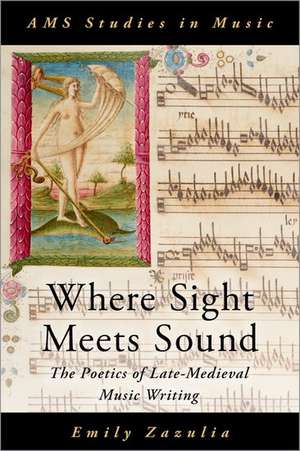Where Sight Meets Sound: The Poetics of Late-Medieval Music Writing: AMS Studies in Music
Autor Emily Zazuliaen Limba Engleză Hardback – 24 mar 2022
Din seria AMS Studies in Music
- 9%
 Preț: 441.64 lei
Preț: 441.64 lei - 10%
 Preț: 440.53 lei
Preț: 440.53 lei -
 Preț: 329.41 lei
Preț: 329.41 lei -
 Preț: 277.43 lei
Preț: 277.43 lei - 20%
 Preț: 259.69 lei
Preț: 259.69 lei - 24%
 Preț: 396.33 lei
Preț: 396.33 lei - 27%
 Preț: 376.39 lei
Preț: 376.39 lei - 12%
 Preț: 293.81 lei
Preț: 293.81 lei - 20%
 Preț: 258.53 lei
Preț: 258.53 lei - 15%
 Preț: 263.82 lei
Preț: 263.82 lei - 5%
 Preț: 233.64 lei
Preț: 233.64 lei -
 Preț: 317.60 lei
Preț: 317.60 lei - 27%
 Preț: 360.45 lei
Preț: 360.45 lei - 30%
 Preț: 495.66 lei
Preț: 495.66 lei - 27%
 Preț: 387.19 lei
Preț: 387.19 lei - 18%
 Preț: 417.30 lei
Preț: 417.30 lei - 23%
 Preț: 342.73 lei
Preț: 342.73 lei - 27%
 Preț: 349.20 lei
Preț: 349.20 lei - 11%
 Preț: 356.33 lei
Preț: 356.33 lei - 13%
 Preț: 298.63 lei
Preț: 298.63 lei - 11%
 Preț: 358.23 lei
Preț: 358.23 lei - 16%
 Preț: 635.67 lei
Preț: 635.67 lei
Preț: 302.06 lei
Preț vechi: 364.47 lei
-17% Nou
Puncte Express: 453
Preț estimativ în valută:
57.81€ • 62.77$ • 48.56£
57.81€ • 62.77$ • 48.56£
Carte tipărită la comandă
Livrare economică 11-17 aprilie
Preluare comenzi: 021 569.72.76
Specificații
ISBN-13: 9780197551912
ISBN-10: 0197551912
Pagini: 340
Dimensiuni: 164 x 239 x 21 mm
Greutate: 0.71 kg
Editura: Oxford University Press
Colecția OUP USA
Seria AMS Studies in Music
Locul publicării:New York, United States
ISBN-10: 0197551912
Pagini: 340
Dimensiuni: 164 x 239 x 21 mm
Greutate: 0.71 kg
Editura: Oxford University Press
Colecția OUP USA
Seria AMS Studies in Music
Locul publicării:New York, United States
Recenzii
One of the great strengths of this book is the way in which it contextualizes these individual pieces-which are often thought of as isolated notational curiosities-in a coherent history extending from the 13th to the 16th century.
This is an outstanding book on the development, aesthetics, and historical context of medieval musical notation.... Essential.
A fascinating examination of the notation of polyphonic works, showing how seemingly recondite formulas serve musical purposes.
With the invention of the ars nova notational system in the early fourteenth century, composers could explore a vast array of previously unavailable rhythmic possibilities. Zazulia's groundbreaking book gives the first detailed account of how this played out in musical practice for the next two hundred years, coming up with new ideas and observations on virtually every page. A major achievement in the history of early music!
A masterful exploration of how late-medieval music notation works and why it matters. Bridging periods too often kept apart and illuminating repertoire both famous and little-known, Zazulia takes us inside a musical world in which writing could carry as much aesthetic weight as sound. Don't miss this terrific book.
This book is a must-read for early-music specialists and a worthwhile investment for any student of music history.
Emily Zazulia's inaugural monograph offers a detailed account of late medieval music notation....Zazulia provides a convincing case that music notation and its associated transformational impulse were some of the most novel technologies of fifteenth century musical creativity.
A virtuosic investigation of the relationship between music as sound and music as text.
This is an outstanding book on the development, aesthetics, and historical context of medieval musical notation.... Essential.
A fascinating examination of the notation of polyphonic works, showing how seemingly recondite formulas serve musical purposes.
With the invention of the ars nova notational system in the early fourteenth century, composers could explore a vast array of previously unavailable rhythmic possibilities. Zazulia's groundbreaking book gives the first detailed account of how this played out in musical practice for the next two hundred years, coming up with new ideas and observations on virtually every page. A major achievement in the history of early music!
A masterful exploration of how late-medieval music notation works and why it matters. Bridging periods too often kept apart and illuminating repertoire both famous and little-known, Zazulia takes us inside a musical world in which writing could carry as much aesthetic weight as sound. Don't miss this terrific book.
This book is a must-read for early-music specialists and a worthwhile investment for any student of music history.
Emily Zazulia's inaugural monograph offers a detailed account of late medieval music notation....Zazulia provides a convincing case that music notation and its associated transformational impulse were some of the most novel technologies of fifteenth century musical creativity.
A virtuosic investigation of the relationship between music as sound and music as text.
Notă biografică
Emily Zazulia is Assistant Professor at the University of California, Berkeley, where she holds the Shirley Shenker Chair in the Arts and Humanities. She has published widely on medieval and Renaissance music, particularly concerning the intersection of complex notation, musical style, and intellectual history. Her research has received support from the National Endowment for the Humanities, the American Council of Learned Societies, the American Musicological Society, the Renaissance Society of America, and the Hellman Foundation.
